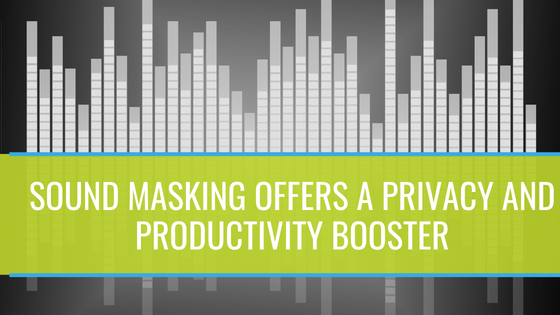In most workplaces, controlling sound is a challenge - but a challenge worth taking on for facility managers. Part of the difficulty is the expense involved with acoustic materials. Creating sound barriers and outfitted surfaces with acoustic material is costly and may require significant alterations to the space.
Sound masking technology is an alternative to sound blocking or absorbing materials. It works by blanketing areas with background sound - an invisible fence through which private conversations and distracting noise cannot pass.
The Modern Office is Full of Noise Distractions
Sound masking solutions are effective in a variety of places, but they're most often found in office buildings. That may be due, in part, to how distracting the modern workplace is. Research developed by UC Irvine found that the typical office worker is interrupted every 11 minutes by noise. And for some workers, it takes more than 20 minutes to get back up to the same working speed. These interruptions can damage your company's bottom line, even if they appear harmless in isolation. It's different for every employee, but the average worker is losing around 5 percent of their day to audio-based distraction. The more employees your company has, the more those productivity losses add up. Adding a sound masking solution to your facilities may save a lot of time in lost man hours.Speech Privacy is a Major Concern for Employees and Companies, but it's Difficult to Find
The other sound-related challenge facing many workplaces is speech privacy. With open offices the standard for professional work, it's nearly impossible to find a place where private conversation can be had. This isn't a trivial issue, either, as worker surveys like the University of Sydney's shows. More than half of the surveyed cubicle and open office workers stated that they were dissatisfied with the speech privacy in their workplace. Only professionals with a private office had a positive impression of their workplace's speech privacy. In professional settings, it's best to keep private conversations private. Many of these conversations, if overheard, could give HR migraines. More importantly, conversations between employees may include sensitive information that your company is legally required to protect. If your organization is regulated or supported by any of the following entities:- HIPAA (Health Insurance Portability and Accountability Act)
- GLBA (Gramm-Leach-Bliley Act)
- HCAHPS (Hospital Consumer Assessment of Healthcare Providers and Systems Survey)
- FERPA (Family Educational Rights and Privacy Act)
Sound Masking Technology Can Create a Comfortable Audio Environment
Creating that comfortable, private space for workers is possible with sound masking technology. Sound masking solutions are simple in design, with steady audio piped through a series of emitters installed throughout the building. These emitters are essentially speakers that can output white noise or pink noise. For most applications, noise that resembles rushing water or wind is the preferred option. However, sound masking systems can be tied to your facility's larger audio system, so it can be used to output music or deliver announcements. The primary goal of sound masking is to make human speech unintelligible over shorter distances. In other words, if a conversation would normally be heard 60 feet away, sound masking may reduce that distance down to 15 feet. Every system can be calibrated for a different "radius of distraction," or the distance at which human speech can no longer be picked up. Ideally, emitters are evenly distributed throughout the floor and in high enough volume to ensure 100 percent coverage. Complete coverage is important because it will interfere with how uniform the system sounds. And if the sound masking solution itself becomes a distraction, that defeats the purpose.The Difference Between Direct and Indirect Sound Masking
There are numerous sound masking solutions on the market, and most of them can be placed in one of two categories - direct and indirect sound masking. What's the difference?- Direct-field systems - With a direct masking solution, the emitters are installed in the ceiling itself and broadcast the audio directly into the workspace. The primary benefit of direct-field solutions is that they can be easily zoned. Facility managers can set the level of audio masking in different spaces, which allows for a custom radius of distraction.
- Indirect systems - An indirect solution places the speakers above the ceiling tiles, in the building's "plenum" where cabling conduit and HVAC components lie. This means the emitters remain invisible, so workers cannot pinpoint where the masking audio is coming from. This can help ensure the system does not become a distraction.
Where Can Sound Masking Solutions Help?
While sound masking technology is an ideal fit for any office space, there are plenty of other applications. They include:- Meeting rooms and huddle rooms
- Research laboratories and engineering labs
- Educational settings, such as libraries and testing rooms
- Hotel reception areas
- Spas
- Hospital and clinic patient areas
- Banks
- Call centers
- Courtrooms and high security facilities
- Airports
- Churches



